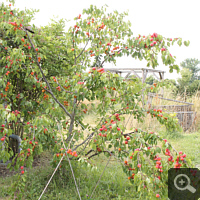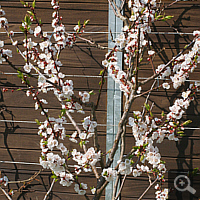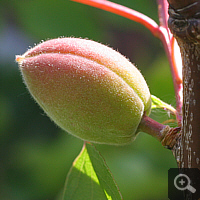Apricot Tree (Prunus armeniaca)
Overview
Further descriptions to the fruits of the Apricot Tree are doubtless be unnecessary. The tree is considered as delicate and is to be found quite rare in German gardens. However, a fear of Apricot Trees is relatively unfounded, because it has indeed its quirks, but it is nevertheless relatively unproblematic.
Description
Already the botanical species name points to the origin of this Rose plant (Rosaceae), namely Armenia. Apricot Trees are relatively growth-restricted and can reach a height of circa five, maximal ten metres.
Culture
The culture is not completely unproblematic. Apricot Trees are indeed well hardy, however late frost-vulnerable, because Apricot Trees belong to those fruit trees, which blossom as the first. If the blossoms are exposed to frost, so unfortunately the harvest will fail in this year. Therefore buy preferably a sort with late blossom.
Another problem is the sensitivity of the Apricot Trees to waterlogging. As possible, provide for a well drained soil. An ideal place for an Apricot Tree is east of a house wall, because in Germany low pressure areas mostly gather from the west and so the tree is something protected against to heavy rainfall. Apricot Trees should be strongly cut each year. Principally similar to an apple tree, however it should be cared for a light crown, so that both fruits and leaves after a shower of rain dry off well and get full sun.
Experiences
2009
Im summer 2009 I bought a circa 1,2 m high Apricot Tree (sort: „Orangered“) and planted it out east of a shed.
2010
The tree survived excellently its first severe winter without any frost protection, without even something freezing to death. In spring 2010 the tree blossomed already very well. After during the blossom night temperatures dipped again almost to freezing, the tree produced no fruits 2010. The good growth is amazing though, in 2010 the sprouts grew almost one metre, so that I will strongly prune the tree 2011.
2011
Also the second winter was survived excellently by the tree without any frost protection. Again the tree bloomed very well and produced als some fruits in better weather than in the previous year.
Unfortunately, this year the tree infected with brown rot, a fungal disease, which is caused by Monilia laxa. Fungal spores penetrate over the blossoms in damp weather and lead within days to a withering of the affected branches because of cell necroses. In this case helps regrettably only a consequently pruning of the affected branches as far as circa 15 cm into the healthy wood (healthy wood is complete pale, whereas affected wood show still brown spots). The cut material must needs be disposed of as residual waste to prevent a new infection in the following year.
2012-2013
In both years, the tree continued to grow well. Unfortunately, it got due to late frost only a handful of fruits.
2014
Due to the extremely warm winter tree flourished already in mid-March. Frost came only mid-May. The tree thanked the favorable weather conditions by a bumper crop of 14 kg.



